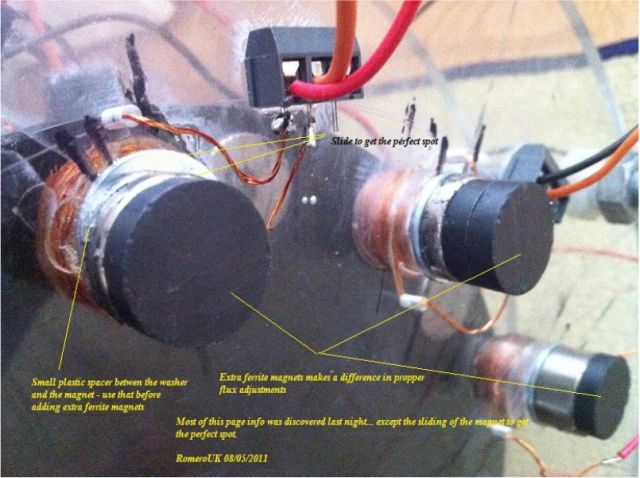RomeroUK

free energy device self running powering lightbulb - RomeroUK Muller Motor - Generator
Selfrunning Free Energy Muller Motor Generator from User RomeroUK powering a 20 Watts bulb
Selfrunning Free Energy Muller Motor Generator from User RomeroUK powering a 20 Watts bulb Version 1.1 from the 9th of May 2011
 Magnet Effect on Pulse Motor for performance enhancement
Magnet Effect on Pulse Motor for performance enhancement
 GAP Adams pulse motor
GAP Adams pulse motor

 David Bowling wrote:
David Bowling wrote:
Doug,
Saw the video you posted and a bit on the discussion about Romero UK and his magnets
on the coil. Here is maybe some insight into how that assists based on my work with
Tesla Coils.
Lenz is a reaction, not a law. Not only that, but it is a reaction
made of many parts. Each happens in order. Mess with any one of them and you affect
the Lenz reaction to some degree.
Take a rotor with all North magnets as an
example. This is what I use, so I am very familiar with it. As a North rotor magnet
approaches the core, it begins to affect the core material, inducing a magnetic field
in it. Every core material has a rate at which it absorbs flux. You can’t speed this
up or slow it down. The field the approaching magnet creates is the opposite polarity
to the approaching magnet, so the end of the core closest to the approaching North
magnet becomes a South magnet, and actually attracts the North rotor magnet. Move a
magnet toward an iron core. It is attracted, NOT repelled. So the INITIAL field in the
core attracts the rotor magnet. But this is going to CHANGE as the Lenz reaction
continues. As this flux field begins to grow it is evenly distributed throughout the
mass of the core, so if you have a very long core that sticks far out the end of the
coil it will take LONGER to fill with flux to the point that the next step in the
“reaction” takes place. So longer cores or MASS of core material affect WHEN Lenz
happens.
Now the wire, if it is attached to the load, begins to accumulate
electricity. It isn’t “INSTANTLY” there. A light connected to the load is not
instantly bright. It takes TIME to light up. The more capacitance the coil has, either
from being wound Tesla style, having a large amount of wire on it, or just having a
capacitor connected to it in parallel, the more time it takes to fill to the point
where the next step in the process takes place. As the electricity accumulates in the
coil it begins to reverse that initial magnetic field in the core. The end closest to
the rotor magnet that WAS South becomes North, repelling the approaching rotor magnet.
But to DO this it must overcome the magnetic field that was initially created. This
too takes time. Delaying the inevitable Lenz.
By adding a magnet to the end of
the core Romero accomplished TWO things. He strengthened the INITIAL magnetic field
that ATTRACTED the approaching rotor magnet, and increased the amount of flux in the
core material that had to be overcome or neutralized before the Lenz reaction could
become complete, thereby delaying it slightly. It isn’t eliminated, but is made less
severe since it has a shorter amount of time to push away the approaching magnet.
This is all conjecture on my part, but is based on my understanding of how the
Lenz reaction takes place and how to outrun it, and experiments I have done on the
bench. Hope it is of value.
One thing I left out that is very important. Romero
adding that magnet caused an INCREASE in the attraction of the core material to the
approaching rotor magnet which is reflected in acceleration of the rotor magnet toward
the core. There would be an equal drag backwards as the rotor magnet tried to move
away from the core but Lenz NEUTRALIZED this backward drag by changing the core
polarity.
Hi Simon,
Earlier this morning I saw this video 1
minutes 49 second long:
https://www.youtube.com/watch?v=_qyJSZbIbws
and read the conversation at
overunity.com:
https://overunity.com/18949/gap-adams-pulse-motor/
As you can see on the
video he is not charging any battery as so many others "free energy" researcher do,
and he is not using a battery as a power supply. Instead he is using a laboratory DC
power supply with a built in voltage, ampere and watt meter.
My question to you
Simon is as I am not a motor builder, can you turn this discovery into a solid state
device? It is similair to the Kunel Generator:
https://solidstateelectricgenerator.files.wordpress.com/2014/12/de3024814.pdf
Norman Wootan said that Heinrich Kunel used a version of his solid state
device to power his home and Heinrich Kunel said to Norman Wootan that
the patentdrawing must be re-made because if you build one of his generators of the
schematic after the patentdrawings you end up with a bad functional device. It is the
airgap that must be abolished. Because air conduct magnetism 4000 times less than
iron. Simon, after you have read what David Bowling has written at:
http://gratisenergi.se/romerouk.htm
Can you tell me, Mehmet and Nick if it possible to do a solid state device of
RomeroUK discovery from 2011?
Best Wishes, Hermes
P.S Mehmet have you
made any version of the Kunel patent?
P.S Nick, have you tested to put a
permanent magnet at the free end of your motor electromagnets at your Adams
motor/generator?
Hi Hermes,
As I've said before, these sorts of
experiments simply bounce energy around in the system and will not be OU. Do you think
that reducing the consumption of a free-running rotor (as in that video) from around
18W to around 10W is significant? It's not actually doing any work other than keeping
spinning, so basically ALL the input power is turned into heat without doing any
useful work. Adding the extra magnets reduces the inefficiency. That's all.
If you really want to produce OU, you need to take into account the speed of light,
and thus you'll need to use frequencies up into the GHz range for a device of this
size. You need to violate CoM and so you need to be using 1/4 wave and 1/2-wave
distances for your frequency and ensure that the action and reaction are in the same
direction rather than equal and opposite. I haven't worked out a way of doing this
with a motor, but it's the only way you'd be able to get an OU motor unless you try
Horizon Mechanics. Note that there's are the problems of near-field to sort out and
overcome, thus using actual 1/4-wave distances doesn't actually work and you need to
use multiples and get into the far-field region (greater than 10 wavelengths) with the
right phase-differences, and the fields drop off at 1/r˛ so you end up with very
little force. As such, you need resonant cavities to get the field-strength high and
in far-field.
I haven't yet seen any way to utilise the violations of basic
laws to produce OU in a solid-state and non-moving device. Yep, you can violate CoM,
but then you need to mount that device on a disc mounted on a generator shaft to
convert that kinetic energy to electricity.
Might end up being possible to get
a fully solid-state system, but you aren't going to get that using the relatively
low-frequencies you can achieve using those sorts of coils, and using transistors that
take around 10ns or more to switch. You won't get enough of a phase-difference to be
measurable.
David Bowling's work is pretty good, and he's experimented with
versions of the Tesla switch. However, the extra energy he's measured (and I'd think
his measurements are both honest and real) is from the extra chemical energy in a
Lead-acid cell, which is normally inaccessible but can be accessed by fast pulses of
high power. He produced those by having somewhat-sparky commutation.
Again as
I've said before, there's not much point in doing the same thing and expecting a
different result. So very many people have tried pulse motors and never managed OU or
even self-running - they always stop. Amongst the group of people who have tried will
be some very bright and competent people. It's a dead-end.
Look at what others
have tried, and figure on doing something significantly different. If you can't think
of something different that will be significant, there's no point in doing it since it
will fail to be OU.
Best regards, Simon
back to linkpage
suggestion
read and sign my
guestbook

